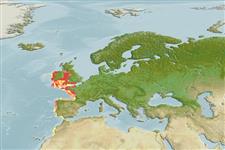Common names from other countries
Elasmobranchii (tubarões e raias) (sharks and rays) >
Rajiformes (Skates and rays) >
Rajidae (Skates)
Etymology: Raja: Latin, raja, -ae = a sting ray (Raja sp.) (Ref. 45335).
Environment: milieu / climate zone / depth range / distribution range
Ecologia
marinhas demersal; intervalo de profundidade ? - 100 m (Ref. 4426). Temperate; 55°N - 24°N, 16°W - 1°W
Eastern Atlantic: southwestern England and Ireland to Rio de Oro in Western Sahara; absent from the North Sea and the Mediterranean.
Comprimento de primeira maturação / Tamanho / Peso / Idade
Maturity: Lm 74.0, range 73 - ? cm
Max length : 87.0 cm TL macho/indeterminado; (Ref. 6014); peso máx. publicado: 4.5 kg (Ref. 4699)
Descrição suscinta
Chaves de identificação | Morfologia | Morfometria
Espinhos dorsais (total) : 0; Espinhos anais: 0. Eyes conspicuously small; dorsal fins close-set, no thorns between; upper surface predominantly spinulose, underside almost smooth in young, but head and centre of disc prickly in larger specimens; orbital thorns separate, a regular row of about 50 thorns from nape to first dorsal fin; upper surface greyish, olive to light brown with light blotches and long bands, underside white (Ref. 3167).
Found on sandy bottoms, from inshore waters to about 100 m in tidal areas (Ref. 3167). Feed on fishes (Ref. 3167). Oviparous. Distinct pairing with embrace. Young may tend to follow large objects, such as their mother (Ref. 205). Eggs are oblong capsules with stiff pointed horns at the corners deposited in sandy or muddy flats (Ref. 205). Egg capsules are 6.6-10.0 cm long and 4.1-6.3 cm wide (Ref. 41250). About 54-61 eggs are laid by an individual in a year (Ref. 41250).
Ciclo de vida ou comportamento de acasalamento
Maturities | Reprodução | Spawnings | Egg(s) | Fecundities | Larvas
Oviparous (Ref. 3167). Paired eggs are laid. Embryos feed solely on yolk (Ref. 50449). Distinct pairing with embrace. Young may tend to follow large objects, such as their mother (Ref. 205).
McEachran, J.D. and K.A. Dunn, 1998. Phylogenetic analysis of skates, a morphologically conservative clade of elasmobranchs (Chondrichthyes: Rajidae). Copeia 1998(2):271-290. (Ref. 27314)
Status na Lista Vermelha da UICN (Ref. 130435)
CITES (Ref. 128078)
Not Evaluated
Ameaça para os humanos
Harmless
Uso pelos humanos
Pescarias: pouco comercial; peixe esportivo: sim
Ferramentas
Relatórios especiais
Baixar XML
Fontes da internet
Estimates based on models
Preferred temperature (Ref.
115969): 10.4 - 15.4, mean 12 (based on 138 cells).
Índice de diversidade filogenética (Ref.
82804): PD
50 = 0.5000 [Uniqueness, from 0.5 = low to 2.0 = high].
Bayesian length-weight: a=0.00468 (0.00297 - 0.00738), b=3.30 (3.17 - 3.43), in cm Total Length, based on LWR estimates for this species & Genus-body shape (Ref.
93245).
Nível Trófico (Ref.
69278): 3.9 ±0.2 se; based on diet studies.
Resiliência (Ref.
120179): Baixo, tempo mínimo de duplicação da população 4,5 - 14 anos (Fec= 54-61).
Fishing Vulnerability (Ref.
59153): Moderate to high vulnerability (55 of 100).
Climate Vulnerability (Ref.
125649): Very high vulnerability (88 of 100).
